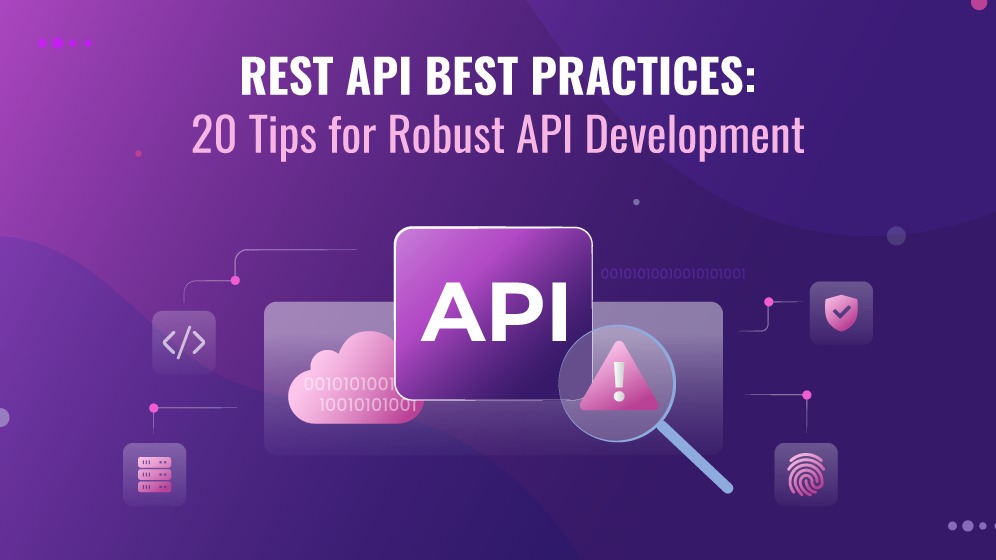REST API Best Practices: 20 Tips for Robust API Development
In today’s digital world, REST (Representational State Transfer) APIs are crucial. They connect systems and power web applications. For businesses, they enable seamless interaction and data sharing. REST APIs form the base of networked software. Hence, they are key components in modern web development. However, to create a successful REST API, you must follow REST API best practices. These best practices will ensure the development of efficient, secure, and easy-to-maintain APIs. Such APIs are essential for businesses aiming for long-term growth and stability.
REST APIs are strategic assets. Proper design, security measures, and maintenance practices are non-negotiable for businesses aiming to succeed digitally. Follow the best practices mentioned below to ensure your REST API optimizes your digital services.
REST API Design Best Practices
Developing a REST API requires attention to detail and focusing on the user’s experience. Here are some REST API best practices to develop user-friendly and consistent APIs.
1. Maintaining consistency:
Creating a uniform experience throughout your API simplifies integration and maintenance. Consistency in design ensures that once developers learn part of your API, they can predict the behavior of the rest.
- Endpoint paths: Stick to a logical hierarchy. For instance, if “/cars” lists all cars, then “/cars/{car_id}” should refer to a specific car.
GET /cars
GET /cars/{car_id}
- Naming conventions: Use consistent naming for your endpoints. Prefer plural nouns (/cars) and avoid mixing camelCase and snake_case.
- Response formats: Decide on JSON, XML, or other formats and use them consistently. Ensure your error messages follow a consistent structure, too.
2. Using HTTP methods appropriately:
HTTP methods offer a built-in framework for most operations you need in your API. Using them according to their intended purpose makes your API intuitive and aligns with web standards.
- GET for retrieval: Use GET to retrieve data. It should be safe and idempotent, causing no side effects. For instance:
GET /cars/{car_id}
- POST for creation: Use POST to create new resources. It can change the state of the server. For example:
POST /cars
- PUT/PATCH for updates: Use PUT to update a resource entirely and PATCH for partial updates. For instance:
PUT /cars/{car_id}
PATCH /cars/{car_id}
- DELETE for removal: Use DELETE to remove resources. For example:
DELETE /cars/{car_id}
3. Keeping a statelessness architecture:
A stateless architecture ensures that each request from a client to a server is independent of the others. This makes your API more scalable and robust, as the server does not need to maintain and synchronize state. Each API call should carry its credentials and data. It should not rely on the server remembering previous interactions. This can be achieved through tokens in the HTTP headers or query parameters, ensuring each request is independent. This principle is especially important in serverless API architectures, where managing state between invocations can be challenging. For example, an API call might look like:
GET /cars/{car_id}?token=xyz
4. Handling errors effectively:
Effective error handling in APIs is crucial for diagnosing issues and providing a clear path for developers to correct their requests. Furthermore, it improves the overall user experience by providing meaningful feedback.
- Using HTTP status codes: Use standard codes like “200” (OK), “404” (Not Found), “401” (Unauthorized), “403” (Forbidden), and “500” (Internal Server Error) to communicate the status of a request.
- Providing error messages: Provide a clear, consistent structure for error messages. Include an error code, a message, and a field indicating where the error occurred.
{
“error”: {
“code”: 404,
“message”: “The requested car ID does not exist.”,
“field”: “car_id”
}
}
You may go for API development services to get assistance with the technical complexities and implement these best practices effectively.
REST API Date Format Best Practices
Managing dates and times correctly is critical for the functionality and reliability of your API. Adhering to REST API date format best practices ensure that your API handles time-sensitive data consistently and accurately, reducing confusion and potential errors for users across different locales and time zones.
5. Standardizing date formats:
Consistent date formats across your API prevent confusion and errors. It’s a crucial aspect of REST API date format best practices, ensuring clear communication about time-related data.
- Maintaining ISO 8601 format: Adopt ISO 8601 for all date and time data. This format is internationally recognized and unambiguous, representing dates like YYYY-MM-DD. For example:
{
“createdAt”: “2024-02-01T09:30:26Z”
}
- Documenting format expectations: Clearly state in your documentation that all dates are in ISO 8601 format. This sets clear expectations and reduces errors.
6. Handling time zones accurately:
Properly handling time zones is vital in a globally connected world. It’s a key part of REST API best practices, ensuring your API serves users accurately across different regions.
- Using coordinated universal time (UTC): Provide all date and time data in UTC to avoid confusion with local time zones.
- Documenting timezone handling: Clearly explain how your API handles time zones. If you convert all times to UTC, make this explicit in your documentation.
7. Formatting date and time in headers:
Properly formatted date and time in HTTP headers are essential for caching and other functionalities. It’s essential to Restful API best practices as it ensures predictable and standardized communication.
- Using standard HTTP date header: Follow the RFC 1123 format for dates in HTTP headers. This standard ensures compatibility across various systems. For example,
Date: Thu, 01 Feb 2024 09:30:26 GMT
- Ensuring accuracy: Ensure your server’s clock is synchronized with a reliable time source. This maintains the accuracy of your date and time headers.
REST API Pagination Best Practices
Efficient pagination is essential for handling large datasets and providing a smooth user experience. By following REST API pagination best practices, your API can deliver data in manageable chunks, optimizing performance and usability.
8. Using cursor-based pagination:
When dealing with large datasets, cursor-based pagination is a performance lifesaver. It’s a cornerstone of REST API best practices, offering a more stable and efficient way to deliver data.
Instead of page numbers, use a cursor that points to a specific item in the dataset. This method is more efficient and reliable, especially when data is frequently added or removed. For example, provide a next cursor in your API response to guide users to the next set of data.
{
“data”: […],
“nextCursor”: “eyJpZCI6MTAyfQ==”
}
9. Providing total counts:
Knowing the total number of items can be useful for clients, but balancing this feature with system performance is important.
- Offering optional totals: Allow clients to request total counts if needed, but be cautious as calculating totals can be resource-intensive on large datasets.
- Indicating totals in responses: When total counts are requested, include them in your API responses. Document that this feature might impact performance. For instance:
{
“data”: […],
“totalItems”: 5200,
“nextCursor”: “eyJpZCI6MTAyfQ==”
}
10. Clearing pagination parameters:
Clear documentation and intuitive pagination parameters are vital. They guide users in effectively navigating through data, aligning with Restful API best practices.
- Documenting parameter usage: Clearly explain how to use parameters like “limit”, “next”, and “previous”. Provide examples to demonstrate their use.
- Naming parameters consistently: To avoid confusion, use consistent and intuitive names for your pagination parameters. For example:
GET /items?limit=20&nextCursor=eyJpZCI6MTAyfQ==
REST API URL Best Practices
Developing well-structured URLs is fundamental for a user-friendly API. Adhering to REST API URL best practices ensures that your endpoints are intuitive, making your API easier to understand and use effectively.
11. Constructing readable and predictable URLs:
Clear and logical URLs form the backbone of any user-friendly API, aligning with REST API best practices for easy navigation and understanding.
- Using hierarchical structures: Arrange your URLs to reflect the relationship between entities. For instance, “/users/{user_id}/orders” to list all orders for a specific user.
- Keeping URLs simple: Avoid complex and lengthy URLs. Stick to a straightforward structure that users can easily read and understand.
12. Using plurals for collections:
Consistent use of plurals in URLs when referring to collections is a subtle yet powerful way to enhance clarity, a key aspect of Restful API best practices.
- Pluralizing resource names: Use plural nouns for collections (e.g., “/users”) and singular nouns for individual items (e.g., “/users/{user_id}”).
- Maintaining consistency: Ensure that you consistently use either singular or plural nouns across your API to maintain a predictable pattern.
13. Enabling filter, sort, and search options:
Providing robust filtering, sorting, and searching capabilities through URL parameters greatly enhances the usability of your API, a testament to following REST API URL best practices.
- Supporting common operations: Allow users to filter (“/users?role=admin”), sort (“/users?sort=age_desc”), and search (“/users?search=John”) through URL parameters.
- Documenting available options: List and explain all the filtering, sorting, and searching options in your API documentation. Provide examples to illustrate their usage.
REST API Versioning Best Practices
Proper versioning of your API safeguards its evolution, ensuring backward compatibility and clear communication with users. Adhering to REST API versioning best practices is crucial for managing changes and maintaining a stable and reliable service.
14. Versioning URI:
Including the API version in the URI is straightforward. It promotes clarity and control, a fundamental aspect of REST API best practices.
- Embedding version in URL: Place the version number directly in the URL path, such as /v1/, to indicate the API version being used clearly. For example:
GET /v1/users
- Supporting multiple versions: This approach allows you to keep various versions of your API simultaneously, ensuring users have time to transition.
15. Using deprecation policy:
A transparent deprecation policy is key to a seamless transition between API versions, aligning with Restful API best practices.
- Documenting policy clearly: Clearly outline how and when versions will be deprecated and what users can expect during the transition period.
- Providing ample notice: Give users enough time to migrate to newer versions and offer support and documentation for assistance in the migration process.
16. Using semantic versioning:
Semantic versioning helps communicate the nature and impact of changes in your API, a crucial part of REST API versioning best practices.
- Structuring version numbers: Use a three-part version number (e.g., 1.0.0), where the first digit is for major changes, the second for minor changes, and the third for patches.
- Communicating changes clearly: Ensure that your API users are well-informed about each version change, especially for major changes that might affect their current implementations.
REST API Security Best Practices
Ensuring the API security is of utmost importance. Following REST API security best practices not only protects your data and services but also maintains the trust of your users.
17. Implementing authentication and authorization:
Proper authentication and authorization are the first lines of defense. These are critical parts of REST API best practices for safeguarding your services.
- Implementing robust authentication: Use standard protocols like OAuth 2.0 to verify the identity of users interacting with your API.
- Enforcing authorization checks: Ensure users have the right permissions to access or modify resources, protecting sensitive data and operations.
18. Securing data transmission:
Encrypting data in transit and at rest is a cornerstone of Restful API best practices, ensuring that sensitive information remains confidential.
- Using HTTPS: Encrypt all data in transit by using HTTPS, protecting it from eavesdroppers and man-in-the-middle attacks.
- Encrypting sensitive data at Rest: Consider additional encryption for sensitive data stored in databases or logs to prevent unauthorized access.
19. Validating inputs:
Validating user input is crucial for protecting your API from malicious attacks, a vital aspect of REST API security best practices.
- Sanitizing inputs: Thoroughly check and clean all incoming data to prevent common vulnerabilities such as SQL injection or XSS.
- Using whitelists: Where possible, define and enforce strict rules about what kind of input is acceptable, minimizing exposure to attacks.
20. Limiting and throttling rates:
Managing the rate of requests is essential for maintaining the stability and availability of your API, aligning with REST API best practices.
- Implementing rate limiting: Set a maximum number of requests a user can make within a certain time frame to prevent abuse and overuse.
- Providing feedback: Inform users when they are approaching or have exceeded their rate limits, guiding them to use your API responsibly.
Conclusion
Embracing REST API best practices is a strategic move for businesses aiming to bolster their digital infrastructure and enhance service delivery. A robust, intuitive API is a linchpin in modern software ecosystems, streamlining interactions and fostering seamless integration. This commitment to API excellence translates into more reliable and efficient operations, reducing maintenance costs and fortifying security—crucial for maintaining client trust and satisfaction.
Adherence to these practices in the swiftly evolving tech landscape equips businesses with agility and adaptability, ensuring they remain updated about the latest technologies and methodologies. This forward-thinking approach is essential for sustaining a competitive edge and ensuring the longevity and relevance of business services.
Integrating REST API best practices is more than a technical mandate—it’s a strategic asset. It underscores a business’s commitment to excellence, security, and continual growth, paving the way for operational excellence and future-focused development.







